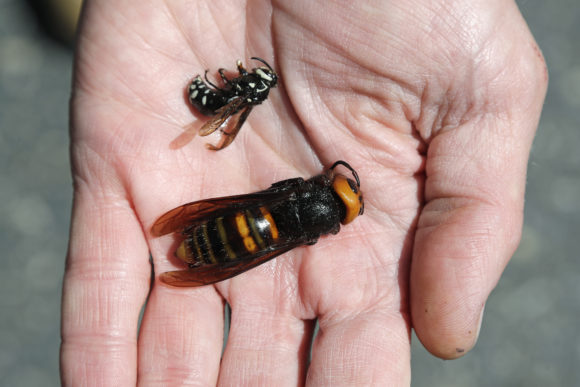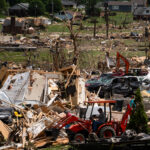SPOKANE, Wash. — Agricultural officials in Washington state said Friday they are trying to find and destroy a nest of Asian giant hornets — also known as murder hornets — amid concerns they could kill honey bees crucial for pollinating raspberry and blueberry crops.
Evidence of six of the hornets were found over the last week near the town of Blaine in Whatcom County, the Washington state Department of Agriculture told reporters.
The number of hornets found — nearly double the previous number discovered in the state — would indicate a nest has been established in the area, the agency said. One of the hornets was trapped alive, a first for the agency, spokeswoman Karla Salp said.
“We believe we are dealing with a nest,” said Sven-Erik Spichiger, a department entomologist. “We hope to locate the nest in a couple of weeks and eradicate it.”
The Asian giant hornet — the world’s largest at 2 inches (5 centimeters) — can decimate entire hives of honeybees and deliver painful stings to humans. Farmers in the northwestern U.S. depend on those honey bees to pollinate many crops.
The invasive insect found in China, Japan, Thailand, South Korea, Vietnam and other Asian countries was first documented in Washington state late last year. Officials have said it’s not known how it arrived. Washington and the Canadian province of British Columbia are the only places the hornets have been found in North America.
There have been reports from Asia of the hornets stinging people so often they have died.
Despite their name, the hornets kill at most a few dozen people a year in Asia, and experts say it is probably far less. Hornets, wasps and bees typically found in the United States kill an average of 62 people a year, the Centers for Disease Control and Prevention has said.
The real threat from the hornets is their devastating attacks on honeybee hives, and the time of year when they attack those hives is nearing, Spichiger said. He called it the “slaughter phase.”
A state scientist managed to trap one live Asian giant hornet near Blaine in recent days and officials tried to glue a radio tag to it so they could follow the hornet back to its nest, Spichiger said.
But the glue did not dry fast enough, the radio tag fell off and the hornet ultimately could not fly, Spichiger said. Scientists hope to capture another live hornet and try again.
People living in the Blaine area have been reporting sightings of the hornets to agricultural officials.
There is also evidence that the giant hornets are also attacking native wasps and hornets, Spichiger said.
Fifteen of the hornets have been found since they were first seen in the state in 2019, the agriculture department said.
About the photo: Washington State Department of Agriculture entomologist Chris Looney displays a dead Asian giant hornet, bottom, a sample brought in from Japan for research, next to a native bald-faced hornet collected in a trap, Thursday, May 7, 2020, in Blaine, Wash. The new Asian hornets that have been found in Washington state may be deadly to honeybees, but bug experts say the Asian giant hornet is not a big threat to people. (AP Photo/Elaine Thompson, Pool)
Was this article valuable?
Here are more articles you may enjoy.


 Chinese Hacked US Telecom a Year Before Known Wireless Breaches
Chinese Hacked US Telecom a Year Before Known Wireless Breaches  Delivery Hero Hit by $376 Million Fine for Glovo Cartel
Delivery Hero Hit by $376 Million Fine for Glovo Cartel  Trump Administration Targets Resiliency Funds to Shrink FEMA’s Role
Trump Administration Targets Resiliency Funds to Shrink FEMA’s Role  Cyberattack Surge Creates Opportunity, Premium Rethink for Insurers
Cyberattack Surge Creates Opportunity, Premium Rethink for Insurers 